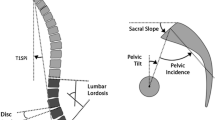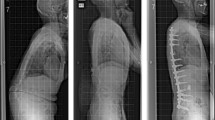Abstract
Degenerative and iatrogenic diseases may lead to loss of lordosis or even kyphotic thoracolumbar deformity and sagittal misalignment. Traditional surgery with three-column osteotomies is associated with important neurologic risks and postoperative morbidity. In a novel technique, the lateral transpsoas interbody fusion (LTIF) is complemented with the sacrifice of the anterior longitudinal ligament and anterior portion of the annulus followed by the insertion of a hyperlordotic interbody cage. This is a less invasive lateral technique named anterior column realignment (ACR) and aims to correct sagittal misalignment in adult spinal deformity (ASD), with or without the addition of minor posterior osteotomies. In this article, we provide an account of the evolution to the ACR technique, the literature, and the Brazilian experience in the treatment of adult spinal deformity with this novel advanced application of LTIF. In the presence of ASD, the risk-to-benefit ratio of a surgical correction must be evaluated. Less invasive surgical strategies can be alternatives to treat the deformity and provide better quality of life to the patient. ACR is an advanced application of lateral transpsoas approach, up to date has shown to be reliable and effective when used for ASD, and may minimize complications and morbidity from traditional surgical procedures. Long-term follow-up and comparative studies are needed to evaluate real benefit.


Similar content being viewed by others
References
Schwab F, Ungar B, Blondel B et al (2012) Scoliosis research society—Schwab adult spinal deformity classification: a validation study. Spine 37(12):1077–1082
Good C, Auerbach J, O’Leary P et al (2011) Adult spine deformity. Curr Rev Musculoskelet Med 4(4):159–167
Hyun S, Kim Y, Rhim S (2013) Spinal pedicle subtraction osteotomy for fixed sagittal imbalance patients. World J Clin Cases WJCC 1(8):242–248
Mummaneni P, Shaffrey C, Lenke L et al (2014) The minimally invasive spinal deformity surgery algorithm: a reproducible rational framework for decision making in minimally invasive spinal deformity surgery. Neurosurg Focus 36(5):E6
Glassman S, Hamill C, Bridwell K et al (2007) The impact of perioperative complications on clinical outcome in adult deformity surgery. Spine 32(24):2764–2770
Schwab F, Hawkinson N, Lafage V et al (2012) Risk factors for major peri-operative complications in adult spinal deformity surgery: a multi-center review of 953 consecutive patients. Eur Spine J 21(12):2603–2610
Akbarnia B, Mundis G, Moazzaz P et al (2014) Anterior column realignment (ACR) for focal kyphotic spinal deformity using a lateral transpsoas approach and ALL release. J Spinal Disord Tech 27(1):29–39
Youssef J, McAfee P, Patty C et al (2010) Minimally invasive surgery: lateral approach interbody fusion: results and review. Spine 35(Supplement):S302–S311
Rodgers W, Gerber E, Rodgers J (2010) Lumbar fusion in octogenarians: the promise of minimally invasive surgery. Spine 35(26 Suppl):S355–S360
Rodgers W, Lehmen J, Gerber E et al (2012) Grade 2 spondylolisthesis at L4-5 treated by XLIF: safety and midterm results in the “worst case scenario”. Sci World 2012:356712
Marchi L, Oliveira L, Amaral R et al (2012) Anterior elongation as a minimally invasive alternative for sagittal imbalance—a case series. HSS J 8(2):122–127
Marchi L, Abdala N, Oliveira L et al (2012) Stand-alone lateral interbody fusion for the treatment of low-grade degenerative spondylolisthesis. Sci World 2012:456346
Mobbs R, Sivabalan P, Li J (2012) Minimally invasive surgery compared to open spinal fusion for the treatment of degenerative lumbar spine pathologies. J Clin Neurosci 19(6):829–835
Haque RM, Mundis GM Jr, Ahmed Y et al (2014) Comparison of radiographic results after minimally invasive, hybrid, and open surgery for adult spinal deformity: a multicenter study of 184 patients. Neurosurg Focus 36(5):E13
Uribe J, Deukmedjian A, Mummaneni P et al (2014) Complications in adult spinal deformity surgery: an analysis of minimally invasive, hybrid, and open surgical techniques. Neurosurg Focus 36(5):E15
Park P, Wang M, Lafage V et al (2015) Comparison of two minimally invasive surgery strategies to treat adult spinal deformity. J Neurosurg Spine 30:1–7
Manwaring J, Bach K, Ahmadian A et al (2014) Management of sagittal balance in adult spinal deformity with minimally invasive anterolateral lumbar interbody fusion: a preliminary radiographic study. J Neurosurg Spine 20(5):515–522
Ozgur B, Aryan H, Pimenta L et al (2006) Extreme Lateral Interbody Fusion (XLIF): a novel surgical technique for anterior lumbar interbody fusion. Spine J 6(4):435–443
Anand N, Baron E, Thaiyananthan G et al (2008) Minimally invasive multilevel percutaneous correction and fusion for adult lumbar degenerative scoliosis: a technique and feasibility study. J Spinal Disord Tech 21(7):459–467
Rodgers W, Cox C, Gerber E (2010) Early complications of extreme lateral interbody fusion in the obese. J Spinal Disord Tech 23:393–397
Marchi L, Oliveira L, Coutinho E et al (2012) The importance of the anterior longitudinal ligament in lumbar disc arthroplasty: 36-month follow-up experience in extreme lateral total disc replacement. Int J Spine Surg 6:18–23
Castro C, Oliveira L, Amaral R et al (2014) Is the lateral transpsoas approach feasible for the treatment of adult degenerative scoliosis? Clin Orthop Relat Res 472(6):1776–1783
Anand N, Rosemann R, Khalsa B et al (2010) Mid-term to long-term clinical and functional outcomes of minimally invasive correction and fusion for adults with scoliosis. Neurosurg Focus 28(3):E6
Wang M, Mummaneni P (2010) Minimally invasive surgery for thoracolumbar spinal deformity: initial clinical experience with clinical and radiographic outcomes. Neurosurg 28(3):E9
Sharma A, Kepler C, Girardi F et al (2011) Lateral lumbar interbody fusion: clinical and radiographic outcomes at 1 year: a preliminary report. J Spinal Disord Tech 24(4):242–250
Acosta F, Liu J, Slimack N et al (2011) Changes in coronal and sagittal plane alignment following minimally invasive direct lateral interbody fusion for the treatment of degenerative lumbar disease in adults: a radiographic study. J Neurosurg Spine 15(1):92–96
Kepler C, Huang R, Sharma A et al (2012) Factors influencing segmental lumbar lordosis after lateral transpsoas interbody fusion. Orthop Surg 4(2):71–75
Amaral R (2015) Lateral interbody fusion with anterior longitudinal ligament release for sagittal correction? A case series. In: 15th Brazilian Congress of Spinal Surgery meeting podium presentation: São Paulo
Turner J, Akbarnia B, Eastlack R, et al (2015) Radiographic outcomes of anterior column realignment for adult sagittal plane deformity: a multicenter analysis. Eur Spine J March: 1–6
Conflict of interest
Dr. Pimenta is a paid consultant, owns stock options, and receives royalties from NuVasive, LLC. Dr. Amaral and Dr. Jensen are paid consultants from NuVasive, LLC. The other authors have nothing to disclose.
Author information
Authors and Affiliations
Corresponding author
Rights and permissions
About this article
Cite this article
Pimenta, L., Fortti, F., Oliveira, L. et al. Anterior column realignment following lateral interbody fusion for sagittal deformity correction. Eur J Orthop Surg Traumatol 25 (Suppl 1), 29–33 (2015). https://doi.org/10.1007/s00590-015-1642-1
Received:
Accepted:
Published:
Issue Date:
DOI: https://doi.org/10.1007/s00590-015-1642-1




